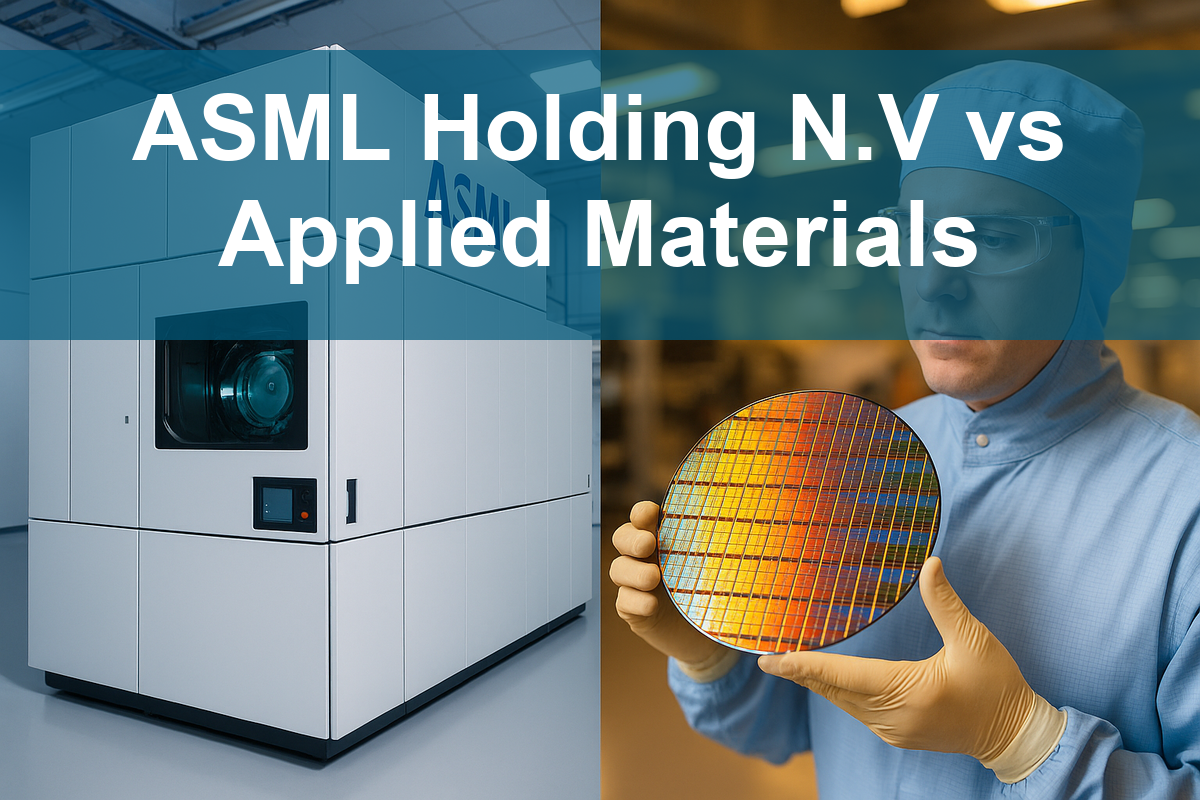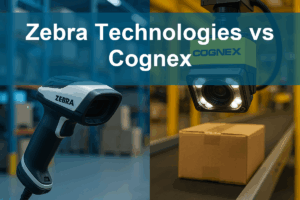In the rapidly evolving semiconductor industry, two prominent players, ASML Holding N.V. and Applied Materials, Inc., are at the forefront of innovation. Both companies provide critical equipment and services that enable chipmakers to meet the growing demand for advanced technology. ASML focuses on cutting-edge lithography systems, while Applied Materials offers a broader range of manufacturing tools across various segments. In this article, I will analyze their strengths and strategies to help you determine which company could be the more intriguing investment opportunity.

Table of contents
Company Overview
ASML Overview
ASML Holding N.V. is a pivotal player in the semiconductor industry, headquartered in Veldhoven, the Netherlands. Founded in 1984, ASML specializes in developing and manufacturing advanced lithography systems essential for chipmakers. Its cutting-edge technologies, including extreme ultraviolet (EUV) and deep ultraviolet (DUV) lithography, play a critical role in producing smaller and more powerful semiconductor nodes. With a market capitalization of approximately $375B, ASML operates globally, serving clients across Asia, Europe, and the Americas. The company is focused on innovation and sustainability in semiconductor manufacturing, positioning itself as a leader in an ever-evolving market.
Applied Materials Overview
Applied Materials, Inc., based in Santa Clara, California, has been a vital component of the semiconductor supply chain since its inception in 1967. With a market cap of around $178B, the company provides manufacturing equipment, services, and software across various segments, including Semiconductor Systems and Display Technologies. Its diverse offerings, ranging from physical vapor deposition to factory automation software, cater to the semiconductor and display industries. Applied Materials emphasizes enhancing productivity and performance for its customers, making it a trusted partner in semiconductor manufacturing.
Key Similarities and Differences
Both ASML and Applied Materials operate within the semiconductor industry, focusing on advanced technologies for chip manufacturing. However, ASML specializes in lithography equipment, particularly EUV systems, while Applied Materials offers a broader range of manufacturing solutions, including services in display technology and factory automation. This distinction highlights ASML’s concentrated expertise versus Applied Materials’ diversified approach to the semiconductor ecosystem.
Income Statement Comparison
In this section, I will compare the income statements of ASML Holding N.V. and Applied Materials, Inc. for the most recent fiscal year, providing insights into their financial performance.
| Metric | ASML | AMAT |
|---|---|---|
| Revenue | 28.26B | 28.37B |
| EBITDA | 10.12B | 9.65B |
| EBIT | 9.21B | 9.54B |
| Net Income | 7.57B | 6.99B |
| EPS | 19.25 | 8.71 |
Interpretation of Income Statement
In the latest fiscal year, ASML reported a revenue increase to €28.26B, a 2.5% rise from the previous year, while Applied Materials slightly outperformed with $28.37B, marking a 4.6% growth. ASML’s net income reached €7.57B, reflecting a decline in profitability margins, whereas AMAT maintained stable net income at $6.99B. Notably, both companies demonstrated robust EBITDA and EBIT figures, but ASML experienced a slight contraction in margins, indicating potential challenges in cost management. Overall, ASML’s performance reveals a need for enhanced efficiency to maintain its competitive edge.
Financial Ratios Comparison
Here is a comparative overview of the most recent revenue and key financial ratios for ASML and Applied Materials (AMAT).
| Metric | ASML | AMAT |
|---|---|---|
| ROE | 41.0% | 34.3% |
| ROIC | 24.9% | 22.0% |
| P/E | 34.8 | 26.8 |
| P/B | 14.2 | 9.2 |
| Current Ratio | 1.53 | 2.61 |
| Quick Ratio | 0.95 | 1.87 |
| D/E | 0.27 | 0.32 |
| Debt-to-Assets | 10.3% | 19.6% |
| Interest Coverage | 56.2 | 30.8 |
| Asset Turnover | 0.58 | 0.78 |
| Fixed Asset Turnover | 3.91 | 6.15 |
| Payout ratio | 33.8% | 19.3% |
| Dividend yield | 0.97% | 0.72% |
Interpretation of Financial Ratios
ASML exhibits a robust return on equity (ROE) of 41%, indicating strong profitability relative to shareholder equity. Although AMAT has a solid performance with a 34.3% ROE, ASML’s higher figures suggest better efficiency in generating profits. Notably, ASML’s lower debt-to-assets ratio (10.3%) reflects stronger financial stability compared to AMAT (19.6%). However, AMAT’s superior current and quick ratios demonstrate better short-term liquidity. Overall, both companies show strengths, but investors should consider ASML’s higher profitability metrics alongside AMAT’s liquidity advantage when making investment decisions.
Dividend and Shareholder Returns
ASML Holding N.V. (ASML) has a dividend payout ratio of 33.8%, with a current annual yield of approximately 0.97% and a consistent trend in dividend payments, reflecting a commitment to shareholder returns. The company also engages in share buybacks, enhancing shareholder value. In contrast, Applied Materials, Inc. (AMAT) maintains a lower payout ratio of 19.3% and a dividend yield of 0.72%, with a focus on reinvesting profits for growth. Both companies exhibit strategies that support sustainable long-term value creation for shareholders.
Strategic Positioning
ASML Holding N.V. (ASML) holds a dominant position in the semiconductor equipment market, boasting a significant market share, particularly in extreme ultraviolet (EUV) lithography systems. Its technology is critical for advanced chip manufacturing, which helps mitigate competitive pressures from companies like Applied Materials, Inc. (AMAT). While AMAT also offers a broad array of semiconductor manufacturing solutions, ASML’s unique technological edge positions it favorably amidst ongoing technological disruptions in the industry. Both companies must navigate increasing competition and evolving market demands to maintain their leadership.
Stock Comparison
In this section, I will provide an analysis of the stock price movements and trading dynamics for ASML Holding N.V. and Applied Materials, Inc. over the past year, highlighting key price fluctuations and overall market trends.

Trend Analysis
ASML Holding N.V. (ASML) Over the past year, ASML’s stock has exhibited a price increase of 27.7%, indicating a bullish trend. The highest recorded price was $1,085.26, while the lowest was $605.55. The trend shows acceleration with a standard deviation of 124.53, suggesting that the stock has experienced notable volatility.
In the recent period from September 7, 2025, to November 23, 2025, ASML’s stock price increased by 23.65%, with a standard deviation of 84.23. This recent trend also indicates a bullish momentum with a trend slope of 17.48.
Applied Materials, Inc. (AMAT) Similarly, AMAT has demonstrated a price increase of 38.22% over the past year, confirming a bullish trend. The stock reached a peak price of $243.4 and a low of $126.95. The trend is characterized by acceleration, supported by a standard deviation of 25.89, which signifies lower volatility compared to ASML.
In the recent timeframe from September 7, 2025, to November 23, 2025, AMAT’s stock price saw a rise of 37.64% with a standard deviation of 23.22. The trend slope of 5.85 further reinforces the bullish outlook for this period.
Both companies show strong upward momentum, making them attractive options for investors looking for growth in the semiconductor sector.
Analyst Opinions
Recent analyst recommendations for ASML Holding N.V. (ASML) and Applied Materials, Inc. (AMAT) both highlight a consensus rating of B+. Analysts note their strong return on equity and return on assets scores of 5, indicating solid profitability. However, concerns about their debt-to-equity and price-to-earnings ratios, scoring 2, suggest caution. Notably, analysts recommend a “hold” position for both companies this year, reflecting a balanced view on their growth potential amidst market uncertainties.
Stock Grades
In reviewing the latest stock ratings from reputable grading companies, we can gather valuable insights into the performance outlook for ASML Holding N.V. (ASML) and Applied Materials, Inc. (AMAT).
ASML Grades
| Grading Company | Action | New Grade | Date |
|---|---|---|---|
| Wells Fargo | maintain | Overweight | 2025-10-16 |
| Susquehanna | maintain | Positive | 2025-10-10 |
| JP Morgan | maintain | Overweight | 2025-10-06 |
| UBS | upgrade | Buy | 2025-09-05 |
| Wells Fargo | maintain | Overweight | 2025-07-08 |
| Jefferies | downgrade | Hold | 2025-06-26 |
| Barclays | downgrade | Equal Weight | 2025-06-03 |
| Wells Fargo | maintain | Overweight | 2025-04-17 |
| Susquehanna | maintain | Positive | 2025-04-17 |
| Raymond James | maintain | Strong Buy | 2025-04-16 |
AMAT Grades
| Grading Company | Action | New Grade | Date |
|---|---|---|---|
| Needham | maintain | Buy | 2025-11-14 |
| Morgan Stanley | maintain | Overweight | 2025-11-14 |
| B. Riley Securities | maintain | Buy | 2025-11-14 |
| Wells Fargo | maintain | Overweight | 2025-11-14 |
| Citigroup | maintain | Buy | 2025-11-14 |
| Mizuho | maintain | Neutral | 2025-11-14 |
| Cantor Fitzgerald | maintain | Overweight | 2025-11-14 |
| Craig-Hallum | downgrade | Hold | 2025-11-14 |
| JP Morgan | maintain | Overweight | 2025-11-14 |
| Stifel | maintain | Buy | 2025-11-11 |
Overall, the trend for ASML shows a strong emphasis on maintaining or upgrading grades, with several firms reiterating their confidence. Meanwhile, AMAT’s grades reflect a similar sentiment, with most analysts maintaining their positive outlook despite a downgrade from Craig-Hallum. This indicates a cautious but generally optimistic view on both stocks.
Target Prices
Based on the latest available data, here are the target prices for ASML Holding N.V. and Applied Materials, Inc., reflecting the consensus among analysts.
| Company | Target High | Target Low | Consensus |
|---|---|---|---|
| ASML Holding N.V. | 1200 | 800 | 1045 |
| Applied Materials, Inc. | 290 | 205 | 246.09 |
For ASML, the consensus target price of 1045 suggests a potential upside from its current trading price of 966.57, indicating positive analyst sentiment. Similarly, Applied Materials has a target consensus of 246.09, compared to its current price of 224.005, suggesting room for growth.
Strengths and Weaknesses
The following table outlines the strengths and weaknesses of ASML Holding N.V. and Applied Materials, Inc. based on the most recent data available.
| Criterion | ASML Holding N.V. | Applied Materials, Inc. |
|---|---|---|
| Diversification | Strong focus on semiconductor equipment | Diverse segments in semiconductors & displays |
| Profitability | High net profit margin (26.79%) | Moderate net profit margin (24.67%) |
| Innovation | Leading in EUV technology | Strong in manufacturing equipment innovations |
| Global presence | Significant operations in Asia & Europe | Established in US, Asia & Europe |
| Market Share | Major player in lithography | Strong presence in semiconductor equipment |
| Debt level | Low debt-to-equity ratio (0.27) | Moderate debt-to-equity ratio (0.32) |
Key takeaways: ASML exhibits strong profitability and innovation in semiconductor technology, while Applied Materials shows a diverse business structure and solid market presence. Both companies maintain manageable debt levels, which can be attractive to investors.
Risk Analysis
The following table outlines the key risks associated with ASML Holding N.V. and Applied Materials, Inc. in the current market environment.
| Metric | ASML Holding N.V. | Applied Materials, Inc. |
|---|---|---|
| Market Risk | Moderate | High |
| Regulatory Risk | High | Moderate |
| Operational Risk | Moderate | Low |
| Environmental Risk | Low | Moderate |
| Geopolitical Risk | High | Moderate |
Both companies face significant market and regulatory risks, particularly given the ongoing global semiconductor demand and supply chain challenges. Recent geopolitical tensions, especially between the U.S. and China, heighten these risks (e.g., export restrictions).
Which one to choose?
In comparing ASML Holding N.V. (ASML) and Applied Materials, Inc. (AMAT), both companies are rated B+ by analysts, indicating solid performance but with room for improvement. ASML’s recent revenue reached 28.3B EUR, showcasing a healthy growth trend, whereas AMAT reported 28.4B USD in revenue with a higher gross profit margin of 48.6% compared to ASML’s 51.3%. Both companies exhibit bullish stock trends, but AMAT shows a higher price change percentage of 38.22% over the last year, compared to ASML’s 27.7%.
For growth-oriented investors, AMAT may be more appealing due to its robust recent performance and lower price-to-earnings ratio of 26.78 compared to ASML’s 34.77. However, ASML’s lower debt-to-equity ratio suggests less financial risk.
Investors should remain cautious of competition and market dependence, which could impact profitability.
Disclaimer: This article is not financial advice. Each investor is responsible for their own investment decisions.
Go further
I encourage you to read the complete analyses of ASML Holding N.V. and Applied Materials, Inc. to enhance your investment decisions:



